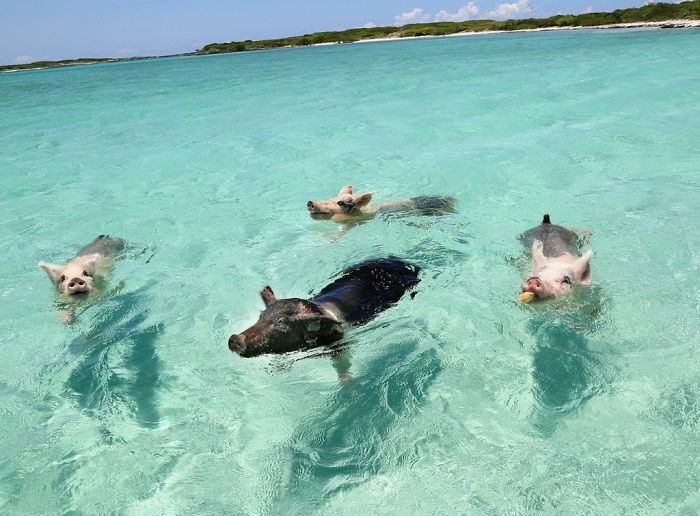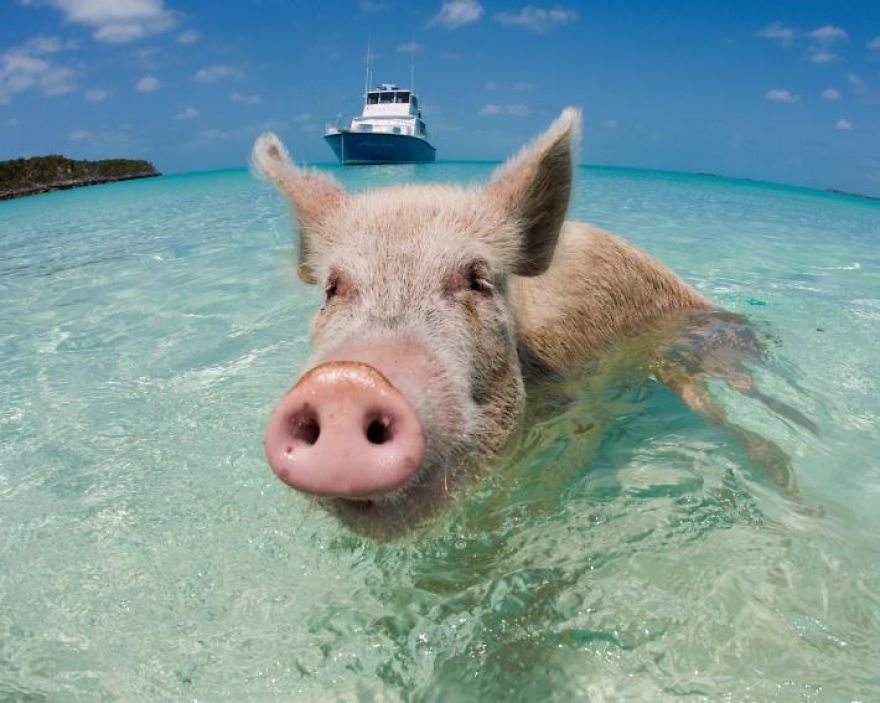The Bahamas are famous for sun, sand—and swimming pigs.
Seven of the feral animals, which are popular as a tourist attraction, have been found dead on Big Major Cay, one of the islands, according to the Bahamas Humane Society. The death toll may be up to 10, which leaves eight or nine of the famous swine remaining—only a handful of which are adults.
Though initial reports suggested that tourists had given the pigs fatal doses of alcohol, Humane Society inspector Ventoi Bethune told National Geographic that the dead swine had likely ingested sand.
Veterinarians who visited the site found large quantities of sand in the deceased animals’ stomachs, which Bethune says may have been caused by a recent influx of visitors throwing small amounts of food on the beach.
“The pigs have been on the island so long, they are used to foraging for natural food,” Bethune says. The pigs would only go the beach for an occasional treat.
But with the increase in tourism, the pigs are relying on humans more than ever.
“They have been getting a lot of international attention recently,” Bethune says. “Now [the pigs] stay on the beach and aren’t living in the forest.” (See more videos of swimming animals.)
The changing climate may also be partly to blame for harming the pigs—the Bahamas experienced an unusually dry January, according to the Caribbean Drought and Precipitation Monitoring Network.
“We found their natural source of water had dried up, so there wasn’t much fresh water on their island to drink,” Bethune says. “We believe it’s a combination of factors that lead to the death of the pigs.”
REINING IN TOURISTS
Wayde Nixon, one of the owners responsible for the pigs, told the Nassau Guardian he blames tourism for the lost pigs.
“[Tourism] is blowing out of proportion,” he says. “Anybody [can bring] food there …. We have people giving the pigs beer, rum … all kinds of stuff.”
The swimming pigs have populated the island for decades, but their actual origin is somewhat of a mystery. Local legend claims they swam ashore after a shipwreck or were left on the island by sailors who planned to come back and eat them, but never returned.
Currently, boats can drive up to the pigs, and it’s legal for tourists to swim with and feed them. (Why we love—and loathe—the humble pig.)
But the deaths may spur new rules to protect the animals, according to a statement from the Minister of Agriculture and Marine Resources, V. Alfred Gray.
“If we have boundary lines, people will be able to take photographs and see the pigs swim, but they will not be able to feed them things.”
The government also plans to post a warden on the beach to protect the animals, Bethune says.
Humane Society President Kim Aranha told newspaper Tribune 242 that local tour operators are respectful of the pig population, but acknowledged that careless boaters can harm the animals.
“I know there are a lot of silly sailors that go and feed them alcohol, but that’s not to mistake them with the tour operators based out of Nassau, who have treated them with excellent care.”
THE FUTURE OF PIG-SWIMMING
Wildlife tourism—which accounts for 20 to 40 percent of all tourism worldwide—is controversial, and can be harmful to animals. After being accused of promoting such attractions, TripAdvisor halted sales to them in 2016.
Many tourists can’t tell if the places they visit hurt wildlife, according to a 2015 ranking of wildlife attractions around the world. Every year, two to four million tourists pay for experiences that aren’t good for animal welfare or conservation.
According to that ranking, dolphin tourism and shark cage diving, both popular in the Bahamas, have negative impacts on wildlife. (See “Why Sharks Are Getting Stuck in Diver Cages”)
But Bethune hopes that, if the proper changes are made, pig-swimming tourism will continue to thrive.
“The pigs themselves have been such a lifeblood for the community. Everyone in the community would still like people to come visit.”
“There’s almost no place you can go to find pigs swimming in the water.”
235views
Share on Facebook




6
1